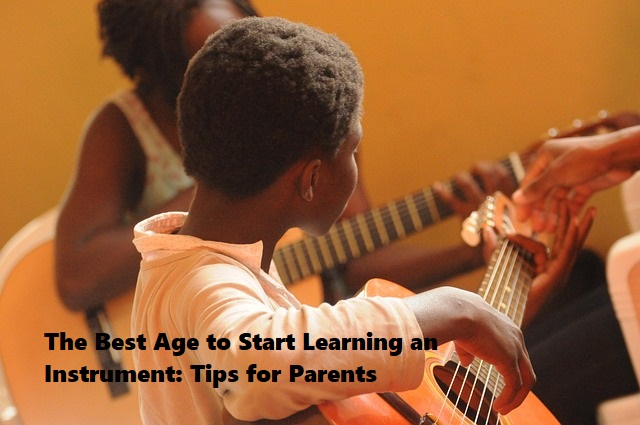Music has long been celebrated as a universal language that enriches the mind, nurtures creativity, and fosters emotional growth. For children, learning to play an instrument offers countless benefits beyond just making melodies. It helps develop discipline, boosts cognitive abilities, and provides an outlet for self-expression. From improved memory to enhanced motor skills, the impact of music on a child’s development is profound and far-reaching. If you’re considering music lessons in New York, you’re giving your child the chance to unlock their full potential through expert guidance and personalized learning experiences.
At MuseCool, we understand the importance of starting your child’s musical journey at the right time and with the right approach. As parents, the desire to give your child every possible advantage in life is natural. However, when it comes to music education, one question often arises: “When is the right time to start?” Is it better to introduce them early for a head start, or should you wait until they show a genuine interest? Navigating this decision can be daunting, especially with so many opinions on the topic.
The truth is, there is no one-size-fits-all answer. Each child develops at their own pace, and the ideal time to begin learning music depends on their readiness, interests, and physical capabilities. A tailored approach, one that considers these unique factors, is key to making their musical journey both enjoyable and successful. In this guide, we’ll explore the best age to start learning an instrument and offer tips to help parents make informed decisions that suit their child’s needs.
Why Age Matters in Music Education
Choosing the right age for a child to begin music education is not just about picking a number—it’s about understanding their developmental readiness. Learning music involves a combination of cognitive, motor, and emotional skills, all of which develop at different rates in every child.
Developmental Readiness
Music education requires a blend of focus, coordination, and emotional engagement. For instance:
- Cognitive readiness: Younger children, especially those under five, are still developing attention spans and memory retention. Starting music lessons too early may lead to frustration if they can’t follow instructions or retain what they’ve learned.
- Motor skills: Fine motor control is essential for playing most instruments, whether it’s pressing piano keys or holding a violin bow. For many kids, these skills begin to develop around ages five to seven, making this an ideal starting point for structured lessons.
- Emotional maturity: Learning an instrument also requires patience and the ability to handle constructive feedback. A child’s temperament plays a role in determining how well they’ll respond to the challenges of music education.
Social Aspects
Music is not only a solitary pursuit but also a highly social activity. Group lessons and ensemble classes provide opportunities for children to develop interpersonal skills and teamwork. Through these settings, kids learn to:
- Collaborate with peers.
- Develop a sense of rhythm and timing within a group.
- Gain confidence by performing in front of others.
For younger children, group lessons can be especially beneficial as they blend play with foundational music skills, making the experience both enjoyable and interactive.
Individual Differences
Every child is unique, and their readiness to start music lessons varies. While one child might show an early aptitude for rhythm, another might need more time to develop focus or fine motor skills. Here are some signs parents can look for:
- A natural curiosity about music, such as singing or tapping along to rhythms.
- The ability to sit still and focus for short periods.
- An eagerness to try new activities or explore different instruments.
By observing their child’s interests and behaviors, parents can gauge whether the time is right to introduce music lessons. Ultimately, aligning the start of music education with a child’s developmental readiness ensures a more positive and rewarding experience.
Age-by-Age Guide to Starting Music
Every stage of childhood brings unique opportunities for engaging with music. By aligning music education with your child’s age and developmental stage, you can ensure a rewarding and enjoyable experience.
| Age Group | Key Features | Recommended Activities/ Instruments | Benefits |
| Toddlers (0–4) | – High curiosity and energy.- Limited attention span.- Early development of sensory and motor skills. | – Interactive group classes focusing on rhythm and movement (e.g., clapping, dancing).- Simple percussion instruments like tambourines, shakers, and drums. | – Builds basic musical awareness.- Enhances coordination and rhythm.- Fosters a love for music through play. |
| Young Children (5–7) | – Better fine motor control.- Increased attention span.- Eagerness to explore structured activities. | – Starter instruments like piano, violin, or ukulele.- Beginner vocal lessons.- Fun group music classes. | – Develops discipline and focus.- Improves hand-eye coordination.- Introduces music reading and basic technique. |
| Older Kids (8–12) | – Enhanced cognitive and physical skills.- Ability to handle more complex concepts.- Growing interest in peer interaction. | – Wind instruments like flute or clarinet.- Brass instruments like trumpet or trombone.- Guitar or drum lessons.- Choir participation. | – Expands creativity and musical range.- Encourages teamwork through ensemble activities.- Strengthens memory and focus. |
| Teens (13 and up) | – Advanced motor skills and cognitive ability.- Stronger sense of identity and self-expression.- Broader musical interests. | – More advanced or complex instruments (e.g., saxophone, cello, or electric guitar).- Songwriting and composition.- Formal vocal training. | – Fosters creativity and emotional expression.- Builds confidence through performance.- Prepares for advanced study or hobbies. |
Key Takeaways by Age
- Toddlers (0–4): Focus on playful engagement to spark interest in music. Classes that incorporate movement and simple rhythms are ideal.
- Young Children (5–7): Introduce structured learning with beginner-friendly instruments. This is a great age for building foundational skills.
- Older Kids (8–12): Explore a broader range of instruments and group settings like bands or orchestras to build technical skills and teamwork.
- Teens (13 and up): Encourage self-expression and mastery of chosen instruments, whether for personal enjoyment or preparation for advanced study.
By understanding the unique opportunities at each stage, parents can make informed choices that align with their child’s readiness and interests.
Factors to Consider When Choosing an Instrument
Selecting the right instrument for your child is a critical step in fostering a successful and enjoyable musical journey. While it’s tempting to pick an instrument based on popularity or parental preference, several factors should guide this decision to ensure the best fit for your child.
Physical Suitability
Not all instruments are suitable for every child, particularly for younger learners with smaller hands or less physical strength. Consider the following:
- Size: Instruments like violins and cellos come in various sizes, making them accessible for even the smallest players. Conversely, large instruments like tubas or double basses may not be practical for young children.
- Strength and dexterity: Instruments such as the piano or ukulele are beginner-friendly and require less physical exertion. Wind instruments, on the other hand, demand lung capacity and embouchure strength, making them better suited for older children.
- Posture and comfort: Children should be able to comfortably hold and play their chosen instrument without strain. For instance, guitars may require specific positioning that younger kids might find challenging.
Interest and Motivation
A child’s enthusiasm for an instrument is a strong predictor of their commitment and enjoyment. Involve them in the decision-making process by:
- Exploring options together: Take your child to instrument discovery sessions or watch videos showcasing various instruments to spark curiosity.
- Listening to their preferences: If a child is fascinated by a particular instrument, such as the piano or drums, their interest will motivate them to practice and improve.
- Starting small: For undecided kids, simpler instruments like recorders or keyboards can serve as an introduction to music, allowing them to transition to more complex instruments later.
Practical Aspects
Beyond the physical and emotional connection, practical considerations play a significant role in choosing an instrument:
- Cost: Some instruments, like violins and guitars, are relatively affordable and widely available. Others, such as pianos or brass instruments, may require a more significant financial investment.
- Maintenance: Consider the upkeep required. String instruments need regular tuning and bow rehairing, while brass instruments require cleaning to maintain sound quality.
- Portability: If your child will be traveling to lessons or performances, lightweight and easily transportable instruments like flutes or violins are ideal. Large or heavy instruments might require logistical planning.
By balancing physical suitability, personal interest, and practical considerations, parents can help their children find the perfect instrument that not only matches their abilities but also inspires a lifelong love for music.
Tips for Parents to Support Their Child’s Musical Journey
Parental support plays a vital role in ensuring a child’s success and enjoyment in learning music. Here are practical tips to help you nurture your child’s passion and guide them through their musical journey.
Creating a Positive Environment
The way music is introduced and practiced at home can shape your child’s attitude toward it.
- Encourage exploration: Allow your child to experiment with different instruments and styles of music. This not only keeps their curiosity alive but also helps them find what resonates with them.
- Make practice fun: Incorporate games or challenges into practice sessions. For instance, you can set small goals with rewards or let them perform mini concerts for family members.
- Celebrate progress: Acknowledge their milestones, whether it’s mastering a song or playing a scale correctly. Positive reinforcement fosters confidence and motivation.
Finding the Right Teacher
The relationship between a student and their teacher is pivotal to a rewarding learning experience.
- Look for expertise and experience: A qualified teacher with a strong background in music education and performance can provide the technical foundation your child needs.
- Prioritize compatibility: A teacher who is patient, encouraging, and adaptable to your child’s learning style can make lessons more enjoyable and engaging.
- Seek feedback: Regular communication with the teacher about your child’s progress and challenges ensures everyone is aligned and working toward shared goals.
Balancing Practice and Play
Striking the right balance between practice and leisure is essential for maintaining your child’s enthusiasm for music.
- Set a routine: Establish a consistent practice schedule that fits into your child’s daily life without overwhelming them. Shorter, focused sessions are often more effective than long, exhausting ones.
- Encourage breaks: Allow time for relaxation and other activities to prevent burnout. Music should complement their life, not dominate it.
- Focus on enjoyment: While discipline is important, the ultimate goal is to make music a joyful part of your child’s life. Encourage them to explore pieces they love alongside their structured lessons.
By creating a supportive environment, choosing the right mentor, and maintaining a healthy balance between practice and play, parents can empower their children to thrive musically while enjoying the journey.
Common Myths About Starting Music Lessons
When it comes to starting music lessons, misconceptions often cloud parents’ decisions. These myths can create unnecessary pressure or deter families from taking that first step. By addressing these misunderstandings, parents can feel more confident in supporting their child’s musical journey.
Myth 1: “You Need to Start Young to Be Successful”
One of the most persistent myths in music education is that children must begin lessons as early as possible to achieve mastery. While early exposure to music offers certain advantages, it’s not the sole path to success. Many accomplished musicians started their training later in childhood or even as teenagers.
Musical growth depends more on consistent practice, quality instruction, and enthusiasm than on age. A child who starts lessons at eight or nine with genuine interest may progress faster than one who begins earlier but lacks motivation. It’s never too late to begin exploring the joys of music.
Myth 2: “Certain Instruments Are Too Hard for Beginners”
Another common belief is that some instruments, such as the violin or trumpet, are inherently more difficult and unsuitable for beginners. In reality, every instrument comes with its unique challenges, and a child’s success depends on their dedication and the guidance of a skilled teacher.
For instance, while string instruments require precision in posture and technique, they also come in child-friendly sizes to accommodate younger players. Similarly, wind instruments like the flute or clarinet may seem daunting at first but can be manageable with proper instruction and gradual progression. The key lies in matching the instrument to the child’s physical readiness and interest.
The Importance of Enjoyment Over Perfection
A focus on perfection in early lessons can quickly drain the joy out of music for young learners. Parents might worry if their child doesn’t master a piece or struggles with certain techniques, but early music education should prioritize fostering a love for the craft over achieving flawless performances.
Encouraging exploration, celebrating small achievements, and allowing room for mistakes help children build a positive relationship with music. Lessons should be a space for creativity and self-expression, where progress is measured not just in technical skill but in the confidence and happiness it brings.
By debunking these myths, parents can approach music education with a more open mind, ensuring their child embarks on a fulfilling and pressure-free musical journey.
How to Get Started
Beginning your child’s journey into music can feel like navigating a maze of options, but taking small, thoughtful steps ensures a smooth and enjoyable start. From exploring trial lessons to setting clear goals, the path to musical success begins with understanding what works best for your child.
Trial Lessons: Exploring Possibilities
Trial lessons are an excellent way to introduce your child to the world of music without long-term commitments. These sessions allow children to explore different instruments and teaching styles, helping them discover what excites them the most.
A trial period can also provide parents with valuable insights into their child’s learning preferences and readiness. For example, a child who enjoys a hands-on, playful approach might thrive in group lessons, while one who prefers focused, individualized attention may benefit more from private sessions.
Equally important is the opportunity to find the right teacher. A good student-teacher match fosters trust and enthusiasm, laying the foundation for long-term growth and enjoyment.
Setting Goals: Aligning Interests and Abilities
Before diving into music lessons, it’s essential to set realistic and meaningful goals. Begin by discussing your child’s interests. Are they drawn to a specific instrument or inspired by a particular type of music? Understanding their preferences ensures they remain engaged and motivated.
Consider their developmental stage and abilities when establishing expectations. A young beginner might focus on basic rhythm and coordination, while an older child might aim to play simple melodies or join a school band. Aligning goals with your child’s capabilities creates a sense of achievement and encourages consistent progress.
Resources for Parents: Building a Supportive Network
Parents play a crucial role in fostering their child’s musical development, and there are many resources to guide you along the way. Workshops and discovery events, such as instrument “petting zoos,” allow children to interact with different instruments in a fun and low-pressure environment.
Online tools and platforms can also be invaluable. For instance, some music programs offer practice plans, progress tracking, and lesson reports to keep both parents and students informed and engaged. Local community centers or music schools often provide group classes and performance opportunities that enhance learning and build confidence.
By combining exploration, clear goal-setting, and a supportive network, parents can ensure their child’s musical journey begins on a positive and inspiring note. Starting small and building gradually is the key to fostering a lifelong love for music.
Conclusion
There is no universal “perfect” age to begin music lessons. Each child embarks on their musical journey at their own pace, shaped by their interests, abilities, and readiness. What truly matters is fostering an environment where music becomes a source of joy, creativity, and personal growth.
As a parent, your role is not to rush the process but to nurture your child’s unique relationship with music. Encourage exploration, celebrate their progress, and focus on creating a positive experience that builds confidence and a lifelong love for learning.
If you’re ready to take the first step, consider exploring music lessons tailored to your child’s individual needs. At MuseCool, we believe every child deserves a musical journey designed just for them, with expert guidance, innovative tools, and a supportive environment. Let’s make those first steps into the world of music inspiring and unforgettable.
Related Post:
Pulsamento | A Revolutionary Concept that Transcends Boundaries







